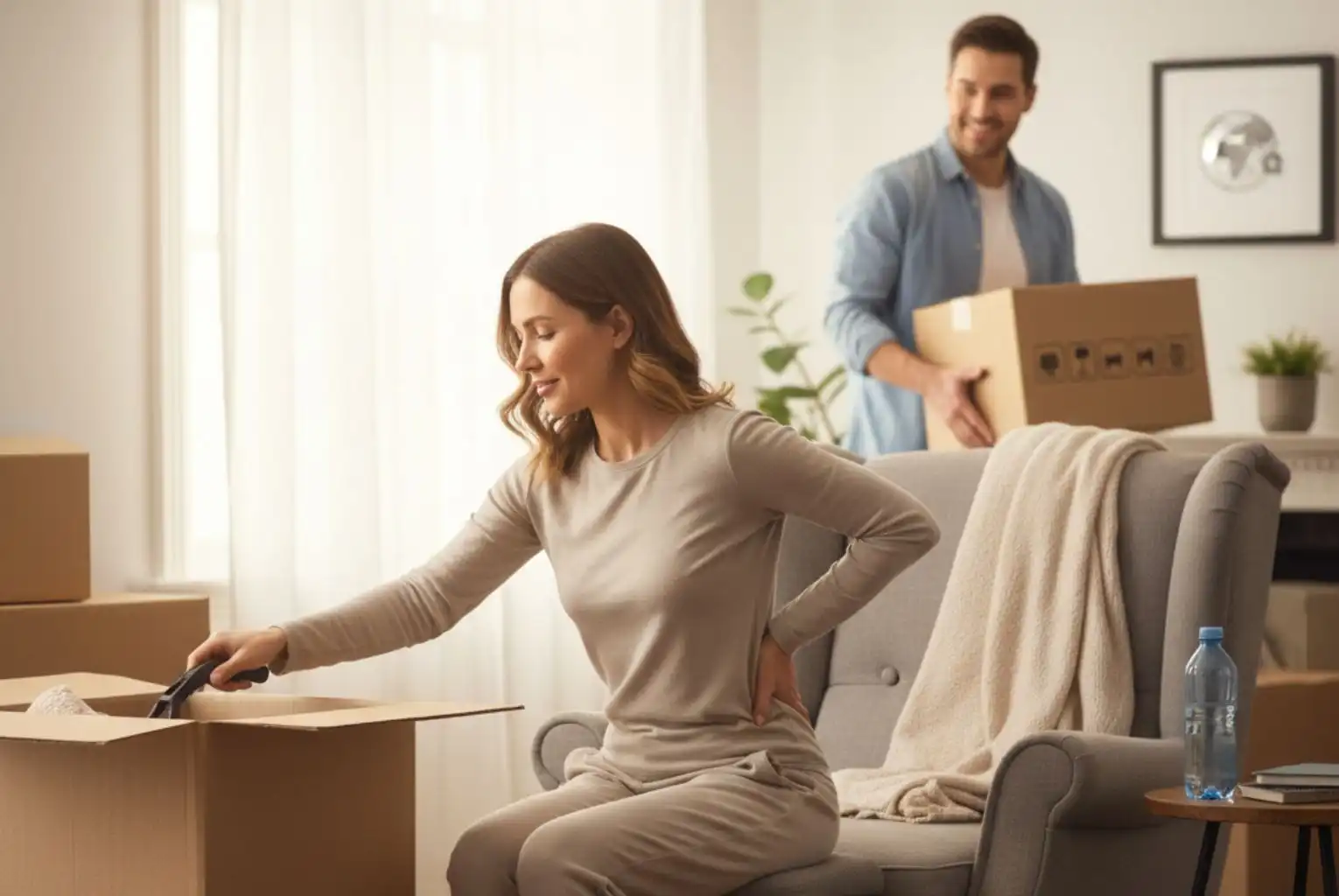MOVING WITH CHRONIC PAIN: STRATEGIES TO MAKE THE JOURNEY EASIER

Introduction
If you’ve ever had to move while already coping with chronic pain, you know it’s not just about boxes and packing tape— it’s about protecting your body and finding ways to get through the process without adding unnecessary strain. Relocation can test even the healthiest among us, and when pain is part of daily life, it takes planning, creativity, and a lot of patience.
The best part? You don’t have to approach it alone or blindly. There are methods to lessen discomfort and help the transition more smoothly, even if you're energy and mobility aren't as great. Think of it less as powering through and more as pacing yourself wisely while using the right help.
Read Also: HOW TO ACE CUSTOMS CLEARANCE IN YOUR INTERNATIONAL MOVE
How Do You Start Preparing for a Move with Chronic Pain?
The first step isn't physical but rather mental. Ask yourself: what’s realistic for me right now? Instead of thinking about what to do about chronic pain in one go, break it down into manageable, small steps. Maybe you sort through a single shelf today and save the rest of the room for tomorrow.
Writing things down helps, too. Create a list of what must be done and spread the tasks over several days or weeks. This not only prevents flare-ups but also takes away the mental burden of “I have to do everything at once.” If you can, let others know about your limitations so they can step in to carry or lift where needed.
Which Strategies Can Help Reduce Pain While Moving?
Moving is a process that involves massive lifting. But you don't need to take on the entire task by yourself. Using strategies to reduce pain while moving is about working smarter, not harder. Consider using a dolly or a rolling cart to transport boxes. You can pack lighter loads rather than packing the cartons full.
Another simple trick is to pay attention to timing. If mornings are when your body feels most comfortable, schedule your physical tasks for then. On the harder days, give yourself permission to stop. Listening to your body is not weakness— it’s wisdom.
Read Also: A PICTORIAL GUIDE TO RELOCATING YOUR ART COLLECTION
Can Gentle Movement Make a Difference?
It might sound counterintuitive, but complete rest isn’t always the best option. Light activity can help reduce stiffness during long moving days. That’s where gentle movement routines for chronic pain come in.
You don’t need an elaborate workout. Just a few shoulder rolls between packing sessions, or standing up to stretch your back after sitting, can make a noticeable difference. Even taking a slow walk around your new space can help keep circulation flowing and muscles relaxed. Think of it as small check-ins with your body rather than structured exercise.
Why Does Stress Management Matter During Relocation?
Let’s be honest— moving is emotional. You’re leaving behind familiar spaces, routines, maybe even neighbours. Add chronic pain to the mix, and stress can climb quickly. That’s why building stress relief for chronic pain patients is so important.
This doesn’t have to be complicated. A ten-minute meditation, listening to your favourite music, or even sipping tea in silence can help calm your nervous system. The calmer you feel, the less your body reacts to stress, which in turn keeps pain from spiralling. Moving is not only about getting things done; it’s also about protecting your peace of mind.
How Do You Stay Mobile Without Making Pain Worse?
Safe movement is critical. Practicing safe movement strategies for chronic pain means paying attention to how you lift, bend, and carry. Always bend at your knees rather than your waist and keep boxes close to your body. Avoid twisting, which can strain the back more than you realize.
If lifting at all feels unsafe, let someone else handle it. Your contribution doesn’t have to be physical— you can direct, organize, or label. These tasks are just as valuable and allow you to stay involved without putting your body at risk.
Read Also: EXPLORING THE UNIQUE RELOCATION PREFERENCES OF YOUNGER MOVERS
What Role Does Pacing Play in the Process?
One of the most overlooked tools for protecting yourself during a move is pacing. Many professionals talk about it as part of managing pain during daily activity, but it’s especially useful here.
Think of pacing as knowing when to stop before your body forces you to. For instance, instead of packing for three hours straight, set a timer and take a break every 20–30 minutes. Use that pause to stretch, hydrate, or simply sit quietly. These small breaks keep you from hitting that wall of exhaustion where everything feels worse.
Should You Consider Professional Support?
Here’s the truth: you don’t have to do everything on your own. Sometimes the best choice is to ask for help. Professional movers exist for a reason—they’re trained to handle the heavy, physical tasks that are hardest on your body.
When you let professionals handle the heavy lifting, you’re free to focus on other things, like setting up your new space or keeping your energy for decision-making. It also gives you more room to practice your own pacing strategies, without the guilt of feeling like you should be doing everything yourself.
Read Also: EQUIPMENT AND TOOLS THAT SET PROFESSIONAL MOVERS APART
Final Thoughts on Moving with Chronic Pain
Living with chronic pain doesn’t mean you can’t relocate—it just means you need a plan that respects your body. With the right pain management strategies, safe movement habits, gentle activity, and intentional rest, moving becomes less about suffering and more about finding ways to adapt.
The goal isn’t perfection; it’s to reduce stress during movement, protect your energy, and arrive in your new space with as little discomfort as possible. Every adjustment you make is an act of care for yourself, and that care pays off long after the last box is unpacked.
At PM Relocations, we understand how overwhelming a move can feel, especially if pain or health challenges are part of your daily life. Our team is here to shoulder the heavy work, so you can focus on settling in with peace of mind. Because a move should be about fresh beginnings—not added pain.
Our Blogs

BEST SCHOOLS IN DELHI: YOUR COMPLETE GUIDE TO THE BEST 10
Finding the right school is one of the most important decisions for parents, especially when moving to a new city like Delhi. With a wide range of CBSE, ICSE, IB, and international schools, the capital offers excellent educational opportunities—but choosing the best one can feel overwhelming. This comprehensive guide to the best 10 schools in Delhi breaks down key factors such as academic excellence, teaching standards, campus facilities, extracurricular activities, and overall student development. Whether you are a local resident or relocating to Delhi, this blog will help you compare top schools and make a confident, well-informed choice for your child’s future.

MOVING TO SPAIN FROM INDIA: BEYOND BEACHES AND INTO A NEW WAY OF LIFE
Moving to Spain from India is not just a change of location—it’s a complete shift in lifestyle, culture, and everyday living. Beyond the famous beaches and vibrant festivals, Spain offers a slower pace of life, a strong work-life balance, and rich traditions that shape daily experiences. From understanding visa requirements and housing options to adapting to Spanish work culture, food habits, and social life, this guide helps Indians prepare for a smooth and confident transition into a new way of life in Spain.

RELOCATING TO NORWAY: NAVIGATING THE COLD-CHAIN CHALLENGE
While most expats worry about visas and housing, many overlook Norway’s most formidable resident: the climate. Navigating the "cold-chain" is the secret to a successful move. From preventing electronics from cracking in sub-zero transit to ensuring your heirloom wooden furniture survives the shift in humidity, mastering the logistics of temperature-sensitive transport is essential for anyone heading North.



